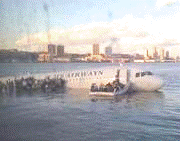Bird Strike Committee Proceedings

Bird Strike Committee-USA/Canada Joint Annual Meeting: 10th (2008)
Date of this Version
8-2008
Document Type
Article
Abstract
Though once endangered, bald eagle populations in the lower 48 States has increased considerably in recent years. Bald eagles far exceed the airworthiness standards for airframes, windshields, and engines set by the Federal Aviation Administration (FAA); consequently this species poses a high risk of damage to aircraft and passenger safety when eagle-aircraft collisions occur. Given the exponential growth of bald eagle populations in the United States, the risk of bald eagle-aircraft collisions is an increasing problem for airports. Concurrently, there is widespread public interest in eagles with a strong concern that eagle populations be protected. Effective, publically accepted methods to reduce the hazards posed by bald eagles using airport environments are needed. USDA Wildlife Services Minnesota program received the first eagle depredation permit in the United States to capture and relocate them to protect aviation safety. In a joint operations-research effort, 5 immature bald eagles will be live-captured and relocated from the St. Paul Downtown Airport (STP) to reduce the risk of bald eagle-aircraft collisions. Project objectives are: (1) to determine if or when translocated immature bald eagles return to the airfield environment from which they are removed and (2) to describe post-translocation movement patterns of immature bald eagles. Captured eagles will be fitted with a GPS-capable satellite transmitter to track each bird’s movements following relocation. Eagles will be transported to a pre-determined relocation site > 150 miles from the airport and released. Bald eagle movement information will be analyzed to determine if translocated immature bald eagles return to the STP airfield environment. In addition, this information will be analyzed to determine what major habitat types eagles use following translocation. This project will provide important information regarding the effectiveness of translocation of immature bald eagles as a method for reducing bald eagle use of airport environments.


Comments
Abstract of poster presentation at Bird Strike Committee USA/Canada Meeting, Lake Mary and Sanford, Florida, August 18–21, 2008.